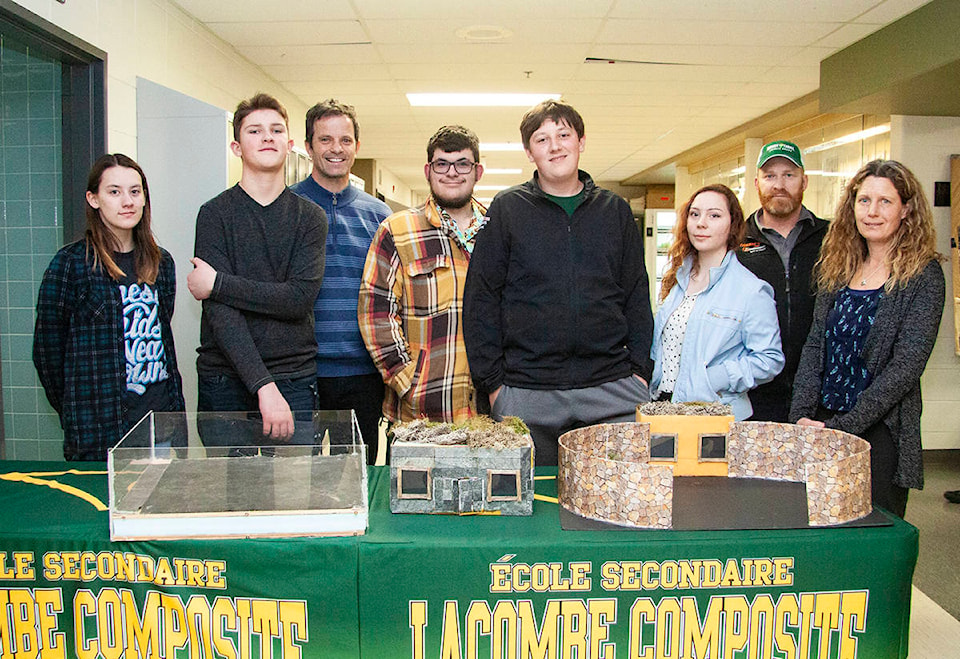Lacombe Composite High School continues to be a central Albertan environmental force with their latest proposed project, which was introduced at a Roofs for Kids event held Monday night.
Darcy Cunningham, Grade 11 student and Ecovision Club member, proposed an idea to teacher Steven Schultz for a new classroom model that could grow to cost as much as $1 million if LCHS is able to find funding.
“It is going to be an outdoor classroom with a living roof and a goat sanctuary,” Cunningham said. “The living roof will be comprised of local native flowers for local insects and birds.”
Cunningham said the idea came to him from his earlier childhood when he would visit his aunt who had goats.
“With the outdoor classroom, I like the idea of students being able to go outside and experience nature while still being at school,” he said. “I believe that can be helpful for students who may not do well in the classroom environment. They are still able to learn.”
Cunningham felt confident enough to pitch the idea because of the support of Schultz and the Ecovision Club, which has previously pioneered projects like a geodesic greenhouse, a beekeeping course and solar panels on top of LCHS.
“I am going to want to see this through and I hope it showcases the technology of living roofs,” Cunningham said. “I believe that can be a very useful technology in the future for teaching students and I believe it can become the norm for people who build big square buildings.”
Cunningham said living roofs have the potential to change agriculture in a world which will be in need of more and more arable land.
“I believe it is a really useful construction technique that can maximize space,” he said. “I think it is great for agriculture. You don’t need hectares of land to grow your crops, you can just rent out an office building in the middle of town.”
While a finished $1 million model would include other livestock like cattle and chickens, Schultz said the starting point of the project with the goats, the agricultural classroom and the living roof would start around $100,000.
Schultz is looking for community support and funding and sees the facility as a potential community hub, but warns that this project is still in its infancy and hasn’t received any approvals yet.
“We haven’t officially received approval, so this is just the launch of our idea,” he said. “It is very expansive and could potentially be around the $1 million mark — if we get buy-in from the community and the school.”
Rockridge Dairy, one of the largest goat-product producers in Canada, Eco Tree and Living Roofs are all companies that are already partnering with Ecovision on this potential project.
“They are a key partner and what is cool about the partnerships is they need more exposure of their products and they want students to be more involved in agriculture,” Schultz said. “It is a win for us because we can expand our education, improve our environment and collaborate with the community.”
Schultz added that goats were a natural starting point for the school because of their many uses including the fact they are a healthy food option, they have therapeutic value as pets and they also can be trained to target invasive weed species on land. He added the living roof portion of the project can help lead the way in finding agricultural land in a growing world.
“To feed nine billion people, we are going to need more land and we don’t have enough,” he said. “That is a fact, so we will have to utilize unused growing space. We want to be an educational leader in living roofs in helping people use their roofs not only for energy — but for growing things.”
After being named Canada’s Greenest School in 2018, Schultz is hoping that LCHS will be able to garner enough funding through grants and community support to get the project off the ground.
“We really hope that this would be a joint venture with the community. We do have space within the facility we are building which means that if we wanted to host a farmers’ market or a fair — we could do that. I see community members coming in and utilizing the space — creating a win-win for the community,” he said.
The potential build will take place north of the gravel parking lot on LCHS property, which provides a lot of space for further growth and is already near the school’s community garden.
Schultz feels this project is a value-added commodity for the City of Lacombe.
“People want to move to communities on the cutting edge,” he said. “Lacombe is becoming that. We are the first school in Canada to have a beekeeping course, we are the first school to have a geodesic greenhouse. All of these things come together like a tapestry that will help out community.”
He added, “If the community wants to get involved, please contact the school 403-782-6615 and ask for Mr. Schulz.”
todd.vaughan@lacombeexpress.com
Like us on Facebook and follow us on Twitter
